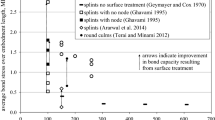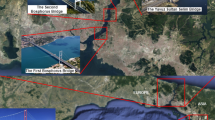Abstract
Timber-concrete structures can be applied to bridge superstructures of vicinal roads with innumerable advantages in relation to the usual structures made of timber or reinforced concrete. This paper presents both an experimental analysis and a theoretical study on models of bridges with timber and concrete composite structures whose systems of connections composed by nails or screws are semi-rigid. The experimental procedure consisted basically of bending tests in three panels, representing a bridge prototype to evaluate the performance structural. Besides this, in order to define the slip modulus shear tests in small specimens were performed. The theoretical study was based on differential equations developed from the equilibrium of forces and the compatibility of displacements and these results were compared to the Finite Element Method. From this analysis, it can be concluded that the timber-concrete composite structures have favorable perspective of application in this type of civil construction.
Résumé
Des structures en bois et en béton peuvent être appliquées à des superstructures de ponts de routes secondaires, offrant plusieurs avantages par rapport aux structures habituelles faites de bois de construction ou de béton armé. Cet article présente une analyse expérimentale et une étude théorique sur des modèles de ponts avec des structures composées en béton et en bois. Les systèmes des connexions sont composés de clous ou de vis et sont analysés comme semi-rigides. Le procédé expérimental consiste fondamentalement en des essais de pliage dans trois panneaux, représentant un prototype de pont afin d'évaluer l'exécution structurel. En plus de cela, de petits spécimens sont cisaillés pour définir le module de glissade. L'étude théorique est basée sur des équations développées à partir d'équilibre des forces et de la compatibilité du déplacement et ses résultats sont comparés avec la méthode des éléments finis. De cette analyse, il se peut être conclu que les structures composées de bois et de béton de construction ont un bel avenir pour les applications de construction civile.
Similar content being viewed by others
References
Ceccotti, A., ‘Timber-concrete composite structures’, Timber Engineering—STEP/EUROFORTECH, Vol 2, Almere: Centrum Hout, 1995, E13 1–12.
Yttrup, P.J., ‘Concrete and timber composite construction for enhanced strength, stiffness and service life for timber bridges’, http://oak.arch.utas.edu.au, Australia (1999).
Newmark, N.M., Siess, C.P. and Viestm, I.M., ‘Tests and analysis of composite beams with incomplete interaction’, Proceedings of Society for Experimental Stress Analysis9 (1) (1951) 75–92.
Brazilian Association of Technical Codes, ‘NBR7190: Timber Structure Design, Brazilian Association of Technical Codes, Rio de Janeiro (1997) [only available in Portuguese].
European Committee for Standardization (CEN), ‘European Prestandard ENV 1993. Eurocode 5: Design of timber structures’, European Committee for Standardization, Brussels (1993).
MATHEMATICA, Ver. 3.0, Champaign, Il: Wolfram Research, Inc.
SAP2000, Ver. 7.0, Berkeley, California: Computers and Structures, Inc.
Brazilian Association of Technical Codes, ‘NBR6118: Concrete Structure Design, Brazilian Association of Technical Codes, Rio de Janeiro (1982) [only available in Portuguese].
Author information
Authors and Affiliations
Rights and permissions
About this article
Cite this article
Mascia, N.T., Soriano, J. Benefits of timber-concrete composite action in rural bridges. Mat. Struct. 37, 122–128 (2004). https://doi.org/10.1007/BF02486608
Received:
Accepted:
Issue Date:
DOI: https://doi.org/10.1007/BF02486608




